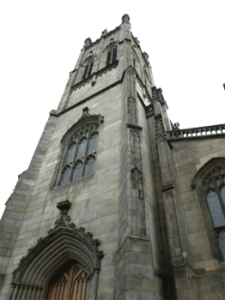Saint Cuthbert of the Cudgel
 Intermediate Deity
Intermediate Deity
Symbol: Ruby-studded starburst
Home Plane: Arcadia
Alignment: Lawful Good (Lawful Neutral tendencies)
Portfolio: Retribution, common sense, wisdom, zeal, honesty, truth, discipline
Worshipers: Fighters, monks, judges, constables
Cleric Alignments: Lawful Good, Lawful Neutral
Domains: Destruction, Law, Protection, Dominion , Strength
Favored Weapon: Heavy Mace
The deity of retribution, St. Cuthbert (saint kuhth-bert), takes many forms. He often masquerades as a common yokel or white-haired, mustached man in plate mail. He usually carries his famous mace.
St. Cuthbert exacts revenge and just punishment on those who transgress the law. Because evil creatures more commonly and flagrantly violate laws than good creatures do, St. Cuthbert favors good over evil, though he is not good himself. He may have once been a mortal man (as his worshipers claim), but if so it was long ago and from an unknown branch of humanity.
Relationships
Saint Cuthbert is a foe of many evil deities, including [Iuz] and Vecna. He also has an intense rivalry with [Pholtus], a similarly intolerant though good-leaning god.
Saint Cuthbert is strongly allied with [Rao]. He is an ally of [Delleb], [Heironeous], and Pelor as well. His worshipers get along well with those of Lendys.
Realm
When they shed their mortal coils, those who worshiped the saint in life go to Saint Cuthbert’s divine realm, called the Basilica of Saint Cuthbert or the Bastion of Law. This realm is in Arcadia. Souls there act as silent observers while the saint gives out judgments from his Seat of Truth. Saint Cuthbert seldom leaves his plane unless some great duty calls him forth.
Dogma
 The words of St. Cuthbert are wise, practical, and sensible. Among his followers, the Word of the Cudgel is law, and his followers take pains to spread the word so that may all may benefit from St. Cuthbert’s wisdom. Weakness in faith and acting against the Saint’s teachings are intolerable, especially in believers. St. Cuthbert exhorts his followers to make increasing efforts to bring unbelievers into the fold. Honesty, truthfulness, practicality, and reasonability are the highest virtues, says St. Cuthbert.
The words of St. Cuthbert are wise, practical, and sensible. Among his followers, the Word of the Cudgel is law, and his followers take pains to spread the word so that may all may benefit from St. Cuthbert’s wisdom. Weakness in faith and acting against the Saint’s teachings are intolerable, especially in believers. St. Cuthbert exhorts his followers to make increasing efforts to bring unbelievers into the fold. Honesty, truthfulness, practicality, and reasonability are the highest virtues, says St. Cuthbert.
Clergy
Clerics of the Cudgel are stern folk who speak their minds plainly. They do not suffer fools and disapprove of those who backslide in faith. They train in the arts of war and keep themselves physically fit. Many serve as constables, detectives, judges, and bounty hunters.
Saint Cuthbert’s priesthood is divided into three major orders.
- The Chapeaux, whose symbol is a crumpled hat, seek to convert people into their faith. They are equally divided between lawful good and lawful neutral characters. Paladins of Saint Cuthbert, known as Votaries or Communicants, have an honorary position in the Order of the Chapeaux. Their role is not just to convert others, but to actually fight enemies of the faith.
- The Stars, whose symbol is a starburst, seek to enforce doctrinal purity among those already dedicated to the saint. Most are lawful neutral, and they do not shy from using mind-reading magic in order to ensure that even the private thoughts of their flock are pure.
- The Billets are the most numerous of Saint Cuthbert’s clergy. Most are lawful good, and they seek to minister to and protect the faithful. These are well-beloved by the common folk. Their symbol is a wooden club. The Chapeaux often come into conflict with the Billets, because the former order wants to seek new converts while the latter wants to care for the worshipers they already have.
Minor orders
There are a few lesser-known orders of St. Cuthbert.
- L’Ordre de la Croix-Rose Veritas, or the Order of the Rosy Cross of Truth, was founded by a former priest of Rao only just converted to Saint Cuthbert’s faith himself. When the priest discovered an evil warlord had been corrupted by a devil in disguise, he founded the new order in order to track down other devils living among mortals in disguise. The order has three branches: La Croix-Vert, La Croix-Blanc, andLa Croix-Bleu.
- The Society of the Sanctified Mind focuses on ridding the world of evil. This society is a knightly order rather than a strictly religious one, and people of a wide variety of character classes belong to it.
Cleric Training
St. Cuthbert teaches new clerics with specially recruited mentors that have drill-sergeant attitudes and stern demeanors. Day and night his acolytes pray, train, and fight, until they can recite entire books of St. Cuthbert’s scripture from memory.
Temples

Temples of St. Cuthbert are always solid and imposing. Their entrances or facades invariably feature inscriptions of quotations attributed to the Cudgel. These can be inspirational, such as: “Chaos and evil prevail where good folk do nothing.” Or even threatening, such as: “Obstinacy brings lumps to the heads of the unfaithful.”
Scriptures
Saint Cuthbert and Common Sense. This short book, normally no more than thirty pages long, uses simple language to explain the tenets of Saint Cuthbert’s faith. Some personal interpretation is permitted, but the essentials (obey the law, be good, and use common sense) remain the same. Those who fail at living up to the Saint’s virtues are advised to turn to their communities for advice and support, and to pray to Saint Cuthbert to clear up their confusion. Copies ofSaint Cuthbert and Common Sense are normally written by hand in easy-to-read letters, sometimes with simple drawings. Gilded illuminations and elaborate calligraphy are not in harmony with the Cuthbertine aesthetic.
Tales of the Vulgar Fool. This book is considered foul heresy in the eyes of Cuthbertines, particularly the Order of the Stars, who try to suppress it whenever it is encountered. It takes the traditional Cuthbertine parables of the Wise Fool and twists them so that instead of overcoming his problems with common sense, he indulges in thievery and lechery. Non-Cuthbertines see these stories as humorous parodies of uptight Cuthbertine homilies, but the church does not approve. A small minority of the faithful take the Tales of the Vulgar Fool to heart and incorporate their “advice” into their lives, and this is the sort of thing the Order of the Stars tries to stamp out.
Quests
Like [Heironeous], St. Cuthbert urges his followers to undertake quests that uphold the chivalric ideal. But more of the Cudgel’s quests involve righting a wrong or avenging a fallen hero. Tracking down the bandits that stole the viscount’s tax collections, imprisoning the blackguard who slew Sir Cyrrus the Bold, and liberating a province conquered by demon armies are all crusades that a follower of St. Cuthbert would lend his sword to.
Prayers
St. Cuthbert’s religious teachings are passed on in the form of commandments, all of which begin “Thou shalt” or “Thou shalt not.” In general, clerics of St. Cuthbert are more likely than most to pepper their speech with “thee,” “thine,” and other archaic pronouns.
Rites
All of St. Cuthbert’s ceremonies include a brief but fiery sermon from a member of the clergy, who exhorts the listeners to turn from their chaotic ways and adhere more closely to the laws of St. Cuthbert.
Herald and Allies
The hound archon hero (described in the archon entry in the Monster Manual) is St. Cuthbert’s herald. Allies are hound archons, half-celestial paladins, and planetars.
